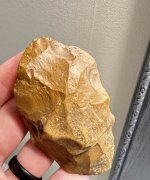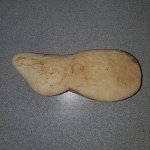Sorry if this has been discussed to death elsewhere (although if it has I couldn't find it; mind you, until I get some paypal funds transfered and join for real I can't search, so what do I know...)
Anyway, I remember from when I was a kid my Dad being very intrigued by a story in the local paper about a bulldozer on the local beach (this was 70s on the South coast of England) that had fortuitously scraped along a compacted layer in the sand and exposed a bunch of stuff. Seems the sand above and below was the same sand, but wave action was packing it at some depth rather than loosening it and turning it over and stuff was just sitting at the interface.
Remembering that got me to thinking about mailoxes and the notion that from most of what I've read people seem to blow a hole down to somthing solid (looks like rocks at Jupiter, "first blood" from the clay at the Wydah, etc). Then when I read SeaHunter's "MY STORY" on the live from Jupiter thread, the comment "Sometimes you would just see coins falling out of the walls as they got bigger" made me think that even after hundreds of years and dozens of hurricanes stuff at some locations is sitting _in_ the sand rather than _under_ it.
The Mailbox/Blower Construction Schematics thread refers to the idea that artifacts may not be "on the bottom" but that thread still, at least in part, seems to obey the logic that it's easier to recover stuff when you blow away all the sand. It seems to me that may be the case when you hit something like a relatively smooth layer of clay, but it may not make things that much easier when you have rocks and crevices as the solid "substrate." What if it's the turbulence from the prop that shuffles the artifacts into the cracks and under the rocks? Might that just be trading a difficult problem for a different but perhaps equally difficult one?
The idea that the mailbox shouldn't point straight down was also mentioned in the construction thread (as I understood it, to prevent trapping the boat in a ring-sandbar when the water is shallow), but that topic also mentioned the idea that if the mailbox is aimed at too shallow an angle the artifacts might be lifted with the wash and simply thrown clear and reburied under the excavated sand. I imagine you folks have observed this process in action (I know I wouldn't be able to resist getting somewhere moderately safe and watching if I was there). So I'm wondering if the concept that the prop wash will pick up coins and lighter artifacts and throw them with the excavated sand could somehow be exploited?
Is it possible that (at least in fairly shallow water) the prop wash could be aimed at a much shallower angle and a net positioned such that the resulting sand-debris-treasure fountain lands on it. If the net is angled "just so" (as Jack Aubrey would say) and has a little water space underneath it, the sand should fall through leaving an enriched collection of coral, beer cans, and 8-escudo royals trapped in the net. The net could be hauled aboard or dumped on a flat area of sand after the pit is completed for hand sorting, or could be MDd in situ. This might have the advantage that non-metal artifacts might also be captured: maybe even a few emeralds. . And you'd _still_ have the pit to investigate in the usual way.
Other than the problem that the net would probably be expensive, and if the mesh is small enough to trap small coins and emeralds it might get clogged with sand and other debris, and the boat is bouncing up and down, and the water is moving side to side, and positioning the net with anchors and floats and PVC pipe may require excessive skill or trickery, does this idea have any merit?
Anyway, I remember from when I was a kid my Dad being very intrigued by a story in the local paper about a bulldozer on the local beach (this was 70s on the South coast of England) that had fortuitously scraped along a compacted layer in the sand and exposed a bunch of stuff. Seems the sand above and below was the same sand, but wave action was packing it at some depth rather than loosening it and turning it over and stuff was just sitting at the interface.
Remembering that got me to thinking about mailoxes and the notion that from most of what I've read people seem to blow a hole down to somthing solid (looks like rocks at Jupiter, "first blood" from the clay at the Wydah, etc). Then when I read SeaHunter's "MY STORY" on the live from Jupiter thread, the comment "Sometimes you would just see coins falling out of the walls as they got bigger" made me think that even after hundreds of years and dozens of hurricanes stuff at some locations is sitting _in_ the sand rather than _under_ it.
The Mailbox/Blower Construction Schematics thread refers to the idea that artifacts may not be "on the bottom" but that thread still, at least in part, seems to obey the logic that it's easier to recover stuff when you blow away all the sand. It seems to me that may be the case when you hit something like a relatively smooth layer of clay, but it may not make things that much easier when you have rocks and crevices as the solid "substrate." What if it's the turbulence from the prop that shuffles the artifacts into the cracks and under the rocks? Might that just be trading a difficult problem for a different but perhaps equally difficult one?
The idea that the mailbox shouldn't point straight down was also mentioned in the construction thread (as I understood it, to prevent trapping the boat in a ring-sandbar when the water is shallow), but that topic also mentioned the idea that if the mailbox is aimed at too shallow an angle the artifacts might be lifted with the wash and simply thrown clear and reburied under the excavated sand. I imagine you folks have observed this process in action (I know I wouldn't be able to resist getting somewhere moderately safe and watching if I was there). So I'm wondering if the concept that the prop wash will pick up coins and lighter artifacts and throw them with the excavated sand could somehow be exploited?
Is it possible that (at least in fairly shallow water) the prop wash could be aimed at a much shallower angle and a net positioned such that the resulting sand-debris-treasure fountain lands on it. If the net is angled "just so" (as Jack Aubrey would say) and has a little water space underneath it, the sand should fall through leaving an enriched collection of coral, beer cans, and 8-escudo royals trapped in the net. The net could be hauled aboard or dumped on a flat area of sand after the pit is completed for hand sorting, or could be MDd in situ. This might have the advantage that non-metal artifacts might also be captured: maybe even a few emeralds. . And you'd _still_ have the pit to investigate in the usual way.
Other than the problem that the net would probably be expensive, and if the mesh is small enough to trap small coins and emeralds it might get clogged with sand and other debris, and the boat is bouncing up and down, and the water is moving side to side, and positioning the net with anchors and floats and PVC pipe may require excessive skill or trickery, does this idea have any merit?





